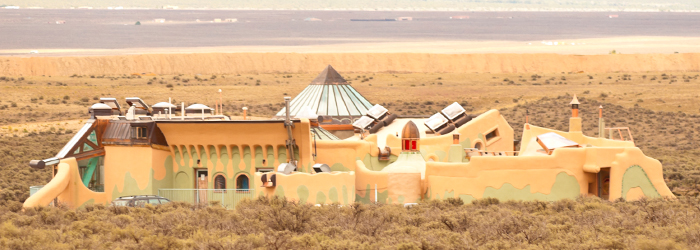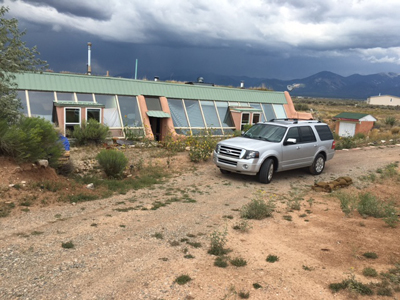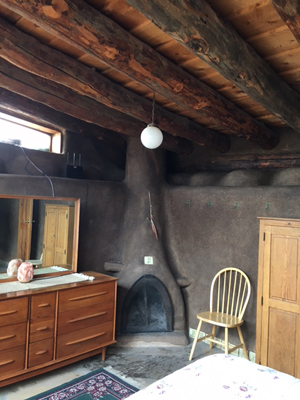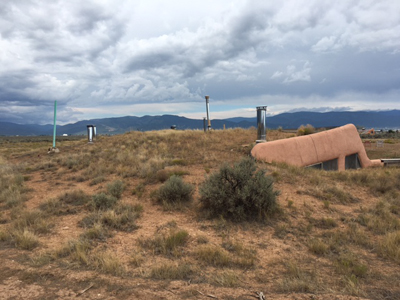What in the World is an Earthship?
 27 September 2016
27 September 2016 

Ever heard of an Earthship? An Earthship is actually a “sustainable” house that was the outgrowth of a 1970s-era housing philosophy that makes use of recycled trash -- everyday stuff like aluminum beer cans, plastic bottles and used tires – as building materials. The idea came from an experimental prophet of green architecture, Michael E. “Mike” Reynolds, who wanted to inspire us to turn leftovers into living units.
I’d first heard about him about the time I graduated from high school; I was fascinated but had never actually seen an Earthship until recently. Reynolds, who graduated from the University of Cincinnati back in 1969, began building his experimental homes in the Taos area and writing books about his concept of the Earthship. He gained some fame from a documentary made about him that was titled “The Garbage Warrior.” But then he sort of disappeared from the media scene. It turns out, however, that he went on building Earthships.
If you’re from Arizona, Reynolds and Earthships may remind you of the ideas of Italian architect Paolo Soleri, who built Cosanti, a studio, art gallery and home in Paradise Valley, and Arcosanti, the experimental town near Prescott.
Then recently, just before a driving trip to Colorado, I went looking for a house to rent in the Taos, N.M., area for a night or two. And there it was online: a whole colony of Earthships, including some for rent about 12 miles (and 20 minutes) out of Taos. As someone who’s always investigating and researching homes of all kinds, young and old, my wife, Jennifer, and I rented an Earthship for two nights. It was not exactly a five-star place, but the price was right – about $130 a night.
This rental used lots and lots of the basic building materials favored by Reynolds – old tires, aluminum cans wired together as bricks and plain old dirt, of which the world has an endless supply. It was a passive-solar structure which meant that it was placed on the lot in the right position to take advantage of sun in the winter and the cooling power of the earth in summer. In other words, the back of the house is buried under the soil that will help maintain an indoor temperature of 72 degrees all year long.
All the floors were compacted earth, sometimes called rammed earth; some were covered with flagstone. The tires and recycled materials weren’t really visible in the soft adobe walls. There were wooden beams and vigas as well. In most respects it reminded me of a highly upgraded cave, very similar to the homes the Anasazi used to build in Arizona and New Mexico. It reminded Jennifer of Soleri’s Cosanti, in fact.
Of course, Reynolds’ plan was to make these homes self-sustaining and completely off-the-grid with no conventional services like electricity. Inside, his plan was for homeowners to grow vegetable gardens inside the Earthship capsule.
The Earthship where we stayed had running water plus fireplaces plus conventional sources of heat. But for our two-night stay in mid-August, we had to open every window and run every fan to cool the place off. There was the usual electric panel and gas-powered hot water heater. But no air conditioner.
The Earthship colony has a visitor center, which is also the site for some more conventional houses as well as 75 Earthships. You can take a guided tour or self-guided tour through the property. Many homes are rented out, for fees as high as $400 a night. Reynolds, who is now 71, is still hard at work on his concept, according to his staff. He’s taking a European lecture tour this fall and then will move on to Indonesia where the government has invited him to build an Earthship on an island. Check out the Web sites earthship.org and earthship.com.
We really enjoyed our stay on the Earthship; we’ll be doing it again!
###
Photo Credits: Rosie on the House
RELATED CONTENT:
- Micheal Reynold's Site: Earthship Biotecture
- DIY Q&A: How can I make my house green?
- DIY Q&A: Resources for Urban Farming
- Podcast: Sustainable Living - Stop the Waste
- Find trusted Arizona contractor and home improvement service providers
Print this page
recent post
- Duck, Duck, Duct! How Often Should Ductwork Be Cleaned?
- Vinyl vs. Fiberglass Windows: Which Is The Better Choice Of Replacement Window?
- We May Be The Grand Canyon State, But The Rocky Mountains Are Important For Arizona
- Welcome to Arizona! Things A Newbie to Arizona Should Know
- The Pros & Cons of Buying A Flipped House
- Getting In On The Ground Floor
- Why It’s More Critical Than Ever To Get Your AC Serviced Before Summer
- The Reality of Remodeling
- What To Look For When Comparing Your Roofing Quotes
- What To Expect When Buying New Windows & Doors
